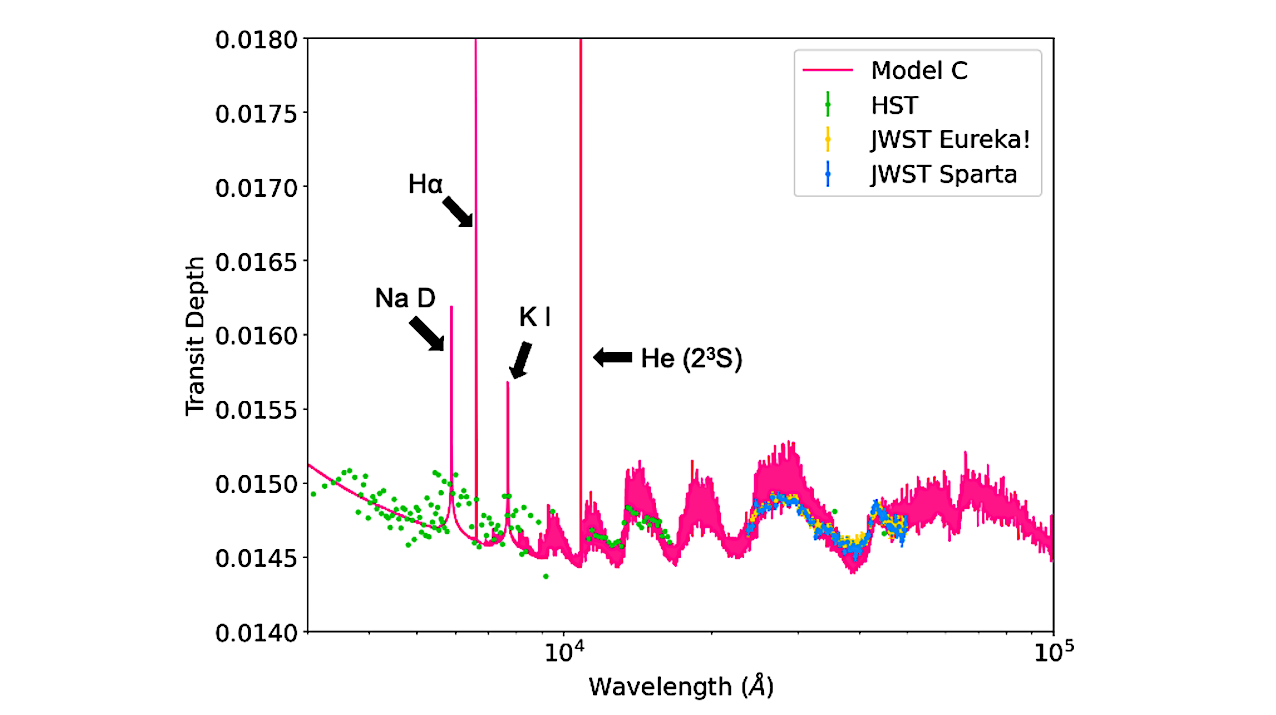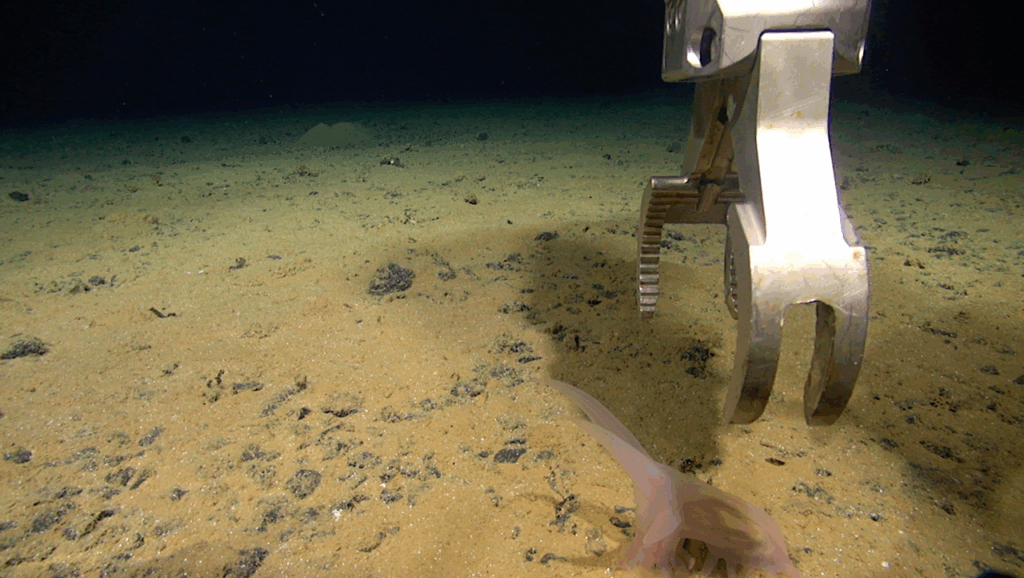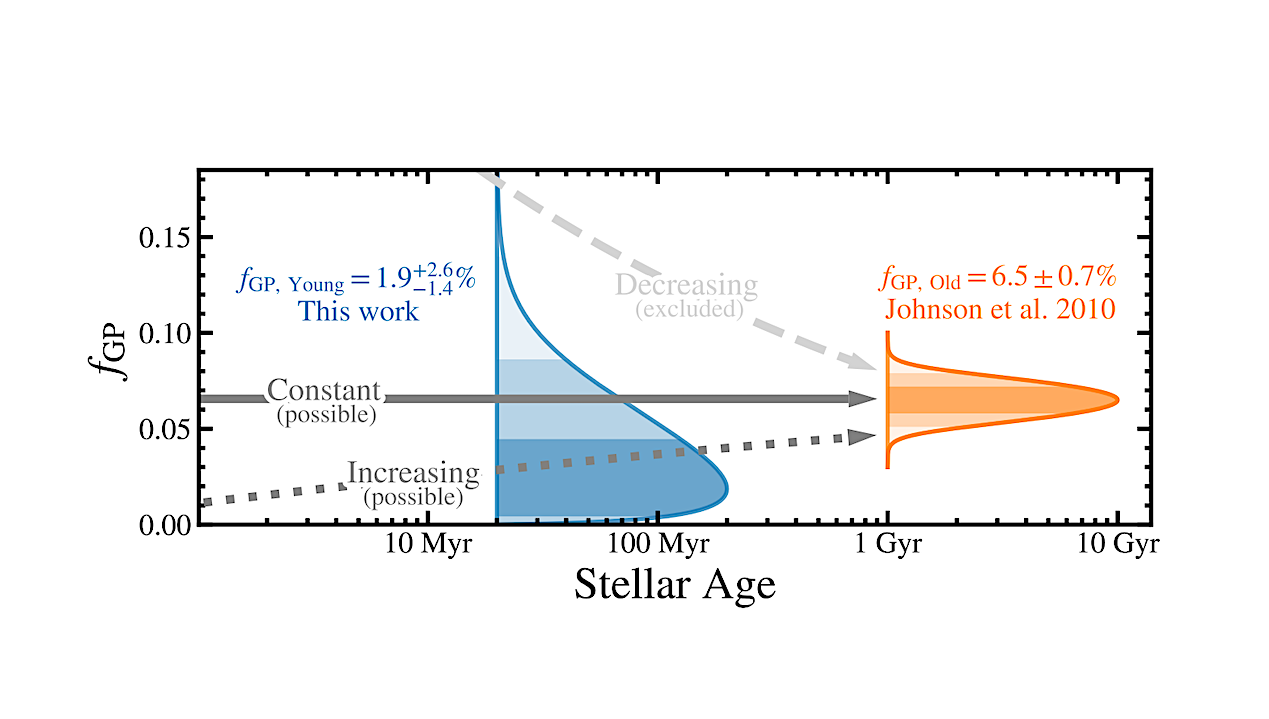Now Reading: A Multi-Species Atmospheric Escape Model with Excited Hydrogen and Helium: Application to HD209458b
-
01
A Multi-Species Atmospheric Escape Model with Excited Hydrogen and Helium: Application to HD209458b
A Multi-Species Atmospheric Escape Model with Excited Hydrogen and Helium: Application to HD209458b


Transit depth versus wavelength for our full atmosphere model of HD209458b (Model C). We zoom in past the extent of the Hα and He I 10830 ˚A line to show the comparison with HST observations (Sing et al. 2016) and JWST observations (with different data reduction pipelines in different colors) (Xue et al. 2024). The JWST observations analyzed can be accessed via DOI:10.17909/f5j3-jq48. Note that the Na D and K I lines are a result of only the lower/middle atmosphere model, and we do not calculate transit depths for these lines based on the upper atmosphere model. — astro-ph.EP
Atmospheric escape shapes exoplanet evolution and star-planet interactions, with He I 10830 Å absorption serving as a key tracer of mass loss in hot gas giants. However, transit depths vary significantly across observed systems for reasons that remain poorly understood.
HD209458b, the archetypal hot-Jupiter, exhibits relatively weak He I 10830 Å and Hα absorption, which has been interpreted as evidence for a high H/He ratio (98/2), possibly due to diffusive separation.
To investigate this possibility and other processes that control these transit depths, we reassess excitation and de-excitation rates for metastable helium and explore the impact of diffusion processes, stellar activity, and tidal forces on the upper atmosphere and transit depths using a model framework spanning the whole atmosphere. Our model reproduces the observed He I transit depth and Hα upper limit, showing strong diffusive separation.
We match the observations assuming a photoelectron efficiency of 20-40%, depending on the composition of the atmosphere, corresponding to mass-loss rates of 1.9−3×1010 g/s. We find that the He I 10830 Å transit depth is sensitive to both stellar activity and diffusion processes, while Hα is largely unaffected due to its strong dependence on Lyman-α excitation.
These differences may help explain the system-to-system scatter seen in population-level studies of the He I line. While He I data alone may not tightly constrain mass-loss rates or temperatures, they do confirm atmospheric escape and help narrow the viable parameter space when interpreted with physically motivated models.
Simultaneous observations of He I, Hα, and stellar activity indicators provide powerful constraints on upper atmosphere dynamics and composition, even in the absence of full transmission spectra.
Anna Ruth Taylor, Tommi T. Koskinen, Luca Argenti, Nicholas Lewis, Chenliang Huang, Anthony Arfaux, Panayotis Lavvas
Comments: 31 Pages, 20 Figures, 3 Tables. Accepted to ApJ on June 9 2025
Subjects: Earth and Planetary Astrophysics (astro-ph.EP); Solar and Stellar Astrophysics (astro-ph.SR)
Cite as: arXiv:2506.08232 [astro-ph.EP] (or arXiv:2506.08232v1 [astro-ph.EP] for this version)
https://doi.org/10.48550/arXiv.2506.08232
Focus to learn more
Submission history
From: Anna Taylor
[v1] Mon, 9 Jun 2025 21:01:34 UTC (5,733 KB)
https://arxiv.org/abs/2506.08232
Astrobiology, Astrochemistry,
Stay Informed With the Latest & Most Important News
-
 012024 in Review: Highlights from NASA in Silicon Valley
012024 in Review: Highlights from NASA in Silicon Valley -
 02Panasonic Leica Summilux DG 15mm f/1.7 ASPH review
02Panasonic Leica Summilux DG 15mm f/1.7 ASPH review -
 03From Polymerization-Enabled Folding and Assembly to Chemical Evolution: Key Processes for Emergence of Functional Polymers in the Origin of Life
03From Polymerization-Enabled Folding and Assembly to Chemical Evolution: Key Processes for Emergence of Functional Polymers in the Origin of Life -
 04How New NASA, India Earth Satellite NISAR Will See Earth
04How New NASA, India Earth Satellite NISAR Will See Earth -
 05And Thus Begins A New Year For Life On Earth
05And Thus Begins A New Year For Life On Earth -
 06Astronomy Activation Ambassadors: A New Era
06Astronomy Activation Ambassadors: A New Era -
07SpaceX launch surge helps set new global launch record in 2024



















